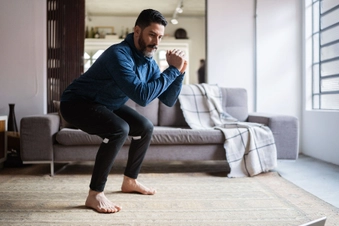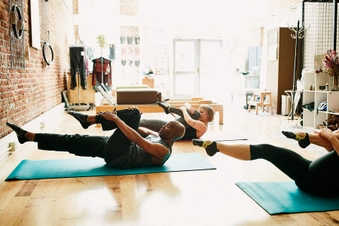Best Exercises for Multiple Sclerosis

Why Exercise Is Important
Doctors and scientists agree that exercise training may be one of the best non-drug ways to manage multiple sclerosis (MS) symptoms. For example, it may loosen stiff muscles that spasm and hurt. And over time, you may get stronger, move better, and feel less tired. But be sure to talk to your doctor before starting an exercise program, especially if you’re not active now.

What Is Exercise Training?
Exercise is planned physical movement. The training part means it’s a thing you do more than once with a goal in mind. The best forms of exercise for MS include aerobics (cardio), stretching, and progressive resistance training, along with balance and coordination practice.

Start With Stretches
Your doctor may call these flexibility or range-of-motion exercises. They aim to lengthen and loosen your muscles. This can ease tightness and spasticity and may help posture and balance. Aim for 10 to 15 minutes of upper and lower body stretching a day, with more attention on the muscles that spasm. Hold each stretch for 20 to 60 seconds. This shouldn’t hurt, but it may feel a bit uncomfortable. Always stretch before and after other exercises, including cardio or strength training.

Get Your Heart Pumping
Regular aerobic exercise can boost your energy and mood. It can also help you think more clearly. And it’s a good way to manage other health problems that can make MS symptoms worse, including obesity and depression. Try to get at least 150 minutes of moderate cardio a week. That’s a pace where you can talk but not sing. You might try walking, jogging, or swimming. A physical therapist can show you how to get your heart rate up if you have limited mobility.

Strengthen Your Bones and Muscles
Resistance or strength training slows muscle and bone loss by working against gravity. Studies suggest this may give you more energy and power for daily things and lower your odds of bone breaks. Include strength training at least two to three times a week. You can use weights, stretchy bands, or your own body. Spend time on each muscle group, but make sure you don’t skip the lower limbs. Leg strength may help you move better.

Keep Getting Stronger
Progressive strength training is when you lift heavier weights over time. There’s strong evidence it can guard against muscle loss and weakness in people with MS. Like other kinds of strength training, aim for two to three sessions a week. If you can, meet with a physical therapist for a safe and detailed plan.

Add Functional Exercises
These mimic movements you do in daily life. For example, bodyweight squats use the same muscles you need to stand up. Push-ups may help you get up from the ground better. Other examples of functional exercises include walking lunges, step-ups, or stair-climbing. Tell your doctor what daily activity you need help with. They’ll help you find the right exercise to target your task.

Try Yoga
This low-impact exercise mixes movement with breathing. It may make you stronger, more relaxed, and less tired. It can also help with balance. As a result, you might find it easier to sit, stand, or walk. Yoga may also help manage the stress of MRI tests and other treatment. You can do yoga almost anywhere, including while seated or standing. You’ll find lots of yoga videos online. But talk to your doctor if you’ve never tried it before.

Practice Pilates
Like yoga, this is a full-body exercise. But Pilates focuses on strengthening your belly (core) muscles. This might improve your balance, posture, flexibility, and strength. If you don’t need a wheelchair, there’s evidence a twice weekly routine may help you walk and move around easier. It’s best to ask your doctor to refer you to a Pilates teacher who works with people who have MS.

Consider Tai Chi
This stress-relieving exercise mixes slow movements with deep breathing. Tai chi has been shown to boost leg strength and flexibility in people with MS. It may ease pain and help with balance, coordination, and overall quality of life. Visit the American Tai Chi & Qigong Association’s website to find a teacher or class near you. Your local community or fitness centers may be other good sources.

How to Cool Off
Exercise can raise your body temperature. That may trigger MS symptoms for a short time. This is called Uhthoff’s phenomenon. You can take extra steps to keep cool. Drink more water, work out in an air-conditioned room, or use a cooling fan. If those don’t help enough, take a cool bath first or wear a cooling vest. If you can, try to exercise in the morning. That’s when your body and outside temperatures tend to be lowest.

Work Out in Water
Pool exercises can help you stay cool while getting a good workout. And you might find it’s easier to move your body in water. Aquatic exercises are known to help with strength, balance, blood flow, and coordination. They might even help you relax. Look for an MS-focused class in your area. These water programs are designed for people with different levels of disability, including those who use assistive tools.

Get a Pre-Exercise Check-up
It’s best to follow an exercise plan tailored to your needs. To figure out which areas need work, your doctor will give you a physical exam and ask some questions. They'll want to know how active you are and which symptoms bother you most. Get your doctor's thumbs up for training. After that, you may need to visit a sports medicine doctor, physical therapist, or rehab specialist. Your MS doctor can let you know who to see.

Take Time to Rest and Recover
It’s natural to feel sore and tired after you exercise. But you shouldn’t feel worse long after you’ve stopped. Some experts use the 2-hour rule: if you feel more run down 2 hours after your workout compared to before you started, you may need to scale things back.
Show Sources
IMAGES PROVIDED BY:
- Portra / Getty Images
- adamkaz / Getty Images
- Jessie Casson / Getty Images
- Trevor Williams / Getty Images
- FG Trade / Getty Images
- Luis Alvarez / Getty Images
- Westend61 / Getty Images
- d3sign / Getty Images
- Thomas Barwick / Getty Images
- Diamond Dogs / Getty Images
- Cavan Images / Getty Images
- kali9 / Getty Images
- Westend61 / Getty Images
- manusapon kasosod / Getty Images
SOURCES:
BMC Neurology: “Exercise prescription for patients with multiple sclerosis; potential benefits and practical recommendations.”
Cleveland Clinic: “Exercise in Multiple Sclerosis,” “Everything You Want to Know About Pilates.”
Penn Medicine: “Multiple Sclerosis and Exercise: Why MS Patients Should Stay Active.”
Multiple Sclerosis and Related Disorders: “Aerobic exercise increases irisin serum levels and improves depression and fatigue in patients with relapsing remitting multiple sclerosis: A randomized controlled trial.”
Mayo Clinic: “Exercise and multiple sclerosis.”
Multiple Sclerosis: “Multiple sclerosis and progressive resistance training: a systematic review.”
American College of Sports Medicine’s Health & Fitness Journal: “Ten Nice-to Know Facts About Functional Training.”
European Review of Aging and Physical Activity: “Systematic review of functional training on muscle strength, physical functioning, and activities of daily living in older adults.”
National Multiple Sclerosis Society: “Yoga and MS,” “Adaptive Tai Chi,” “Aquatic Exercise Programming for People with Multiple Sclerosis,” “Stretching with a Helper for People with MS.”
PLOS One: Tai Chi for health benefits in patients with multiple sclerosis: A systematic review.”
Journal of Bodywork and Movement Therapies: “Pilates for rehabilitation in patients with multiple sclerosis: A systematic review of effects on cognition, health-related physical fitness, general symptoms and quality of life.”
International Journal of MS Care: “Impact of Pilates Exercise in Multiple Sclerosis.”